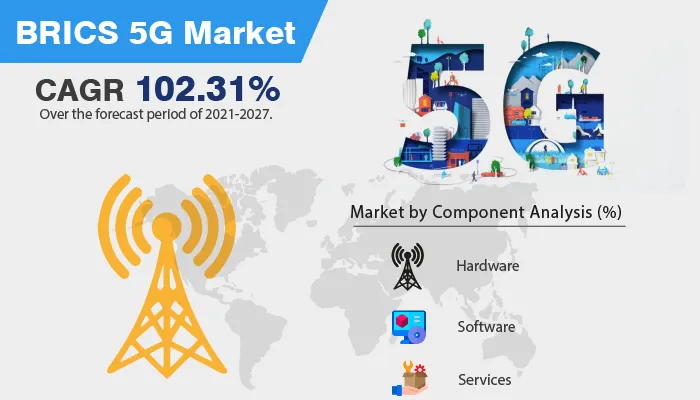BRICS 5G Market (Component - Hardware, Software, and Services; Connectivity - Enhanced Mobile Broadband (eMBB), Ultra-reliable Low Latency Communication (URLLC), and Massive Machine Type Communication (mMTC); Application - Connected Vehicles, VR & AR, Enhanced Video Services, and Others; End User - IT & Telecom, Automotive, Government, and Others): Industry Analysis, Trends, Size, Share and Forecasts to 2027
A recent report published by Infinium Global Research on the 5G market provides an in-depth analysis of segments and sub-segments in the BRICS as well as regional 5G market. The study also highlights the impact of drivers, restraints, and macro indicators on the BRICS and regional 5G market over the short term as well as long term. The report is a comprehensive presentation of trends, forecast and dollar values of the BRICS 5G market. According to the report, the BRICS 5G market is projected to grow at a CAGR of 102.31% over the forecast period of 2021-2027.
Market Insight
The BRICS 5G market was valued at USD 1978.08 million in 2021 and is anticipated to reach USD 135611.97 million in 2027, growing with a CAGR of 102.31% during the projection period. 5G is the fifth generation technology standard for broadband cellular networks and is intended to boost the speed, reduce latency and improve the flexibility of wireless services. Furthermore, 5G technology has a theoretical peak speed of 20 GBPS, while the peak speed of 4G is only 1 GBPS. In addition, 5G takes the connectivity to the next level by delivering experiences from the cloud to clients. 5G networks are envisaged and software-driven and they exploit cloud technologies. Moreover, the 5G technology will also simplify mobility with seamless open roaming competencies between cellular and Wi-Fi access. The new Wi-Fi 6 wireless standard share traits with 5G, comprising improves performance. Wi-Fi 6 radios can be placed where consumers need them to provide better geographical coverage and lower cost.
Increasing demand for IoT connected devices, growing adoption of mobile broadband as well as rising device-to-device communication, and rapid innovation virtualization in the networking domain are driving the growth of the 5G market. Furthermore, 5G offers techniques like network function virtualization and network slicing that help in providing customer-specific networks. Therefore, 5G network can offer customized infrastructure for IoT applications to increase the efficiency of the industry for example industry 4.0 fully depends upon robotics and moving robots to increase the efficiency of the plant. On the other hand, high spectrum prices and the threat of cyber-attacks can hamper the growth of the 5G market. The chances of cyber-attacks are likely to upsurge with 5G technology. The increasing connected devices and machines will lead to an increase in security threats and attackers can take the advantage of this security gap which can adversely affect the growth of the 5G market.
BRICS 5G market shares are predicted to exhibit significant growth prospects over the forecast period. Countries such as India and China are anticipated to have major contributions owing to numerous on-going initiatives and developments. 5G is the most presumed technology of 2021 in India. With Jio, Airtel, VI working towards it, companies across the country are preparing for it. Furthermore, Reliance Jio has confirmed that its 5G Core network and 5G radio have a network bandwidth of 1 Gbps. With such speeds, data consumption is bound to upsurge dramatically and transform the way we do our regular talks at work and in our personal lives.
Segment Covered
The report on BRICS 5G market covers segments such as component, connectivity, application, and end user. On the basis of component, the sub-markets include hardware, software, and services. On the basis of connectivity, the sub-markets include enhanced mobile broadband (eMBB), ultra-reliable low latency communication (URLLC), and massive machine type communication (mMTC). On the basis of application, the sub-markets include connected vehicles, VR & AR, enhanced video services, and others. On the basis of end user, the sub-markets include it & telecom, automotive, government, and others.

Companies Profiled:
The report provides profiles of the companies in the market such as Huawei, Ericsson, Samsung, ZTE, Comba Telecom Systems, Alpha Networks, Intel Corporation, MediaTek Inc., NEC Corporation, and Vodafone Group PLC.
Report Highlights:
The report provides deep insights into the demand forecasts, market trends, and micro and macro indicators. In addition, this report provides insights into the factors that are driving and restraining the growth in this market. Moreover, The IGR-Growth Matrix analysis given in the report brings an insight into the investment areas that existing or new market players can consider. The report provides insights into the market using analytical tools such as Porter's five forces analysis and DRO analysis of 5G market. Moreover, the study highlights current market trends and provides forecast from 2021-2027. We also have highlighted future trends in the market that will affect the demand during the forecast period. Moreover, the competitive analysis given in each regional market brings an insight into the market share of the leading players.
Please Choose One of them.